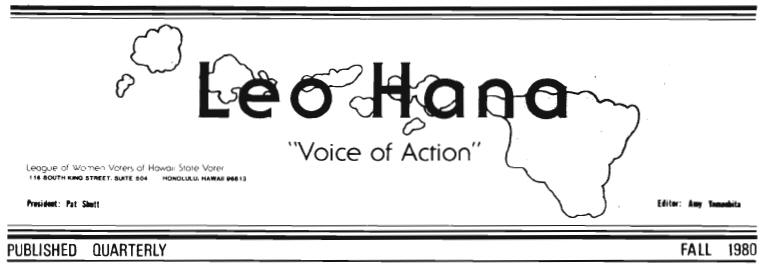 Summer 1980
Summer 1980Fall 1980
 March 1981
March 1981 Summer 1980 Summer 1980 |
Home
Newsletters
Fall 1980 |  March 1981 March 1981 |

 Hazardous Waste in Hawaii? (Anna Hoover) Hazardous Waste in Hawaii? (Anna Hoover) Recommended Readings Recommended Readings Help Wanted Help Wanted Hilo Members Attend Conference Hilo Members Attend Conference Local League News Local League News It's Direct Mail Time! It's Direct Mail Time! Observations of an Election Observer (Anne Marie Duca) Observations of an Election Observer (Anne Marie Duca) ABC Team Does Great Job in Spite of Landslide Victory... ABC Team Does Great Job in Spite of Landslide Victory... |
Hazardous Waste in Hawaii?
Why were the drums unmarked? How could this accident have happened? How much unmarked hazardous waste is disposed at landfills? What might happen if this acid reacts with other chemicals in the landfill? Are there rules and regulations governing the disposal of hazardous waste in Hawaii? What are hazardous wastes? Why were illegal barrels of a pesticide -- dibromochloropropane (DBCP) -- recently found in a Mililani dump? Congress has defined hazardous wastes as discarded material that is a threat to human health or the environment when improperly handled. They may be solids, liquids, sludges, or contained gases. Although legally considered solid waste, hazardous wastes are regulated separately from household and industrial trash deposited in sanitary landfills. These materials, improperly handled, will pollute our air, poison our ground and surface water, invade the food chain, and harm employees at work. Unless prompt and effective action is taken to manage hazardous materials safely, it may not be too farfetched to add homo sapiens to the list of endangered species. The solution to this problem lies in the cooperative efforts between government, industry, and the public to provide strict regulation and, equally important, good facilities for treatment and storage. According to present Hawaii State rules and regulations, each county is responsible for seeing that facilities for the disposal of hazardous waste are available. Toxic, caustic, volatile, and flammable chemical waste may be incinerated; made non-hazardous by chemical neutralization at a landfill; or placed in a specially constructed trench. Pesticides are to be disposed of in special incinerators. If there are no incinerators, pesticides may be buried in specially designated places at the landfill and a record kept of these locations. Radioactive wastes and explosives are prohibited in Hawaiian landfills. There are no incinerators specifically for hazardous waste disposal in Hawaii. Several cement companies have furnaces with adequate temperatures, but the companies do not want to handle hazardous waste. At present, hazardous wastes are shipped to the mainland for proper disposal by a private company, Unitek. Unitek was created to specialize in transporting hazardous waste from Hawaii to an excellent disposal facility in Oregon. The Navy and other companies in Hawaii are presently shipping hazardous waste to other sites on the mainland. In an effort to prevent future Love Canals, the U.S. Congress passed the Resource Conservation Act of 1976 (RCRA). This Act mandates the Environmental Protection Agency (EPA) to develop a nationwide program for solid waste management. The Hawaii Department of Health (DOH) is presently revising state regulations for solid waste management control -- which includes the regulation of hazardous waste -- to comply with the mandate. As a result of the comprehensive RCRA, beginning November 19, 1980, hazardous waste nationwide will be monitored from "cradle to grave" -- that is, from the time the waste is generated to its final disposal. Each shipment of wastes leaving a plant must be accompanied by forms identifying the company which produced the wastes, the shipper hauling them, and the company storing or disposing of the wastes. The company generating the waste must get a copy of the form back in 35 days from the dump site or it must find out why it hasn't received the form and report any problems to the EPA. The EPA is further directed by RCRA to carry out a hazardous waste program in any state that has not developed an approved hazardous waste management system. At this time, the Hawaii DOH has decided to work out a cooperative hazardous waste management agreement with the EPA. The DOH will conduct inspections while the EPA will take responsibility for the hazardous waste program in Hawaii. There are still many questions about hazardous waste and solid waste management in Hawaii. If you would like to look more closely at these issues, please contact your local president or Anna Hoover (on Oahu) at 373-9605. Anna Hoover |
 Summer 1980 Summer 1980 | Home Newsletters |  March 1981 March 1981 |